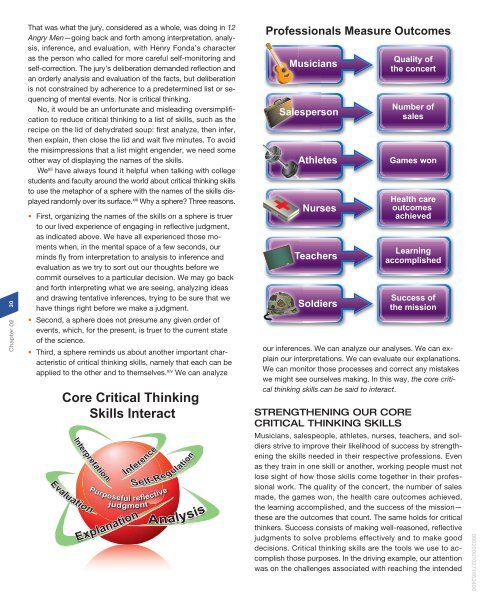Critical Thinking Disposition Self- Rating Form. - Pearson Learning ...
Critical Thinking Disposition Self- Rating Form. - Pearson Learning ...
Critical Thinking Disposition Self- Rating Form. - Pearson Learning ...
Create successful ePaper yourself
Turn your PDF publications into a flip-book with our unique Google optimized e-Paper software.
Chapter 02 30<br />
That was what the jury, considered as a whole, was doing in 12<br />
Angry Men—going back and forth among interpretation, analysis,<br />
inference, and evaluation, with Henry Fonda’s character<br />
as the person who called for more careful self-monitoring and<br />
self-correction. The jury’s deliberation demanded reflection and<br />
an orderly analysis and evaluation of the facts, but deliberation<br />
is not constrained by adherence to a predetermined list or sequencing<br />
of mental events. Nor is critical thinking.<br />
No, it would be an unfortunate and misleading oversimplification<br />
to reduce critical thinking to a list of skills, such as the<br />
recipe on the lid of dehydrated soup: first analyze, then infer,<br />
then explain, then close the lid and wait five minutes. To avoid<br />
the misimpressions that a list might engender, we need some<br />
other way of displaying the names of the skills.<br />
We xii have always found it helpful when talking with college<br />
students and faculty around the world about critical thinking skills<br />
to use the metaphor of a sphere with the names of the skills displayed<br />
randomly over its surface. xiii Why a sphere Three reasons.<br />
• First, organizing the names of the skills on a sphere is truer<br />
to our lived experience of engaging in reflective judgment,<br />
as indicated above. We have all experienced those moments<br />
when, in the mental space of a few seconds, our<br />
minds fly from interpretation to analysis to inference and<br />
evaluation as we try to sort out our thoughts before we<br />
commit ourselves to a particular decision. We may go back<br />
and forth interpreting what we are seeing, analyzing ideas<br />
and drawing tentative inferences, trying to be sure that we<br />
have things right before we make a judgment.<br />
• Second, a sphere does not presume any given order of<br />
events, which, for the present, is truer to the current state<br />
of the science.<br />
• Third, a sphere reminds us about another important characteristic<br />
of critical thinking skills, namely that each can be<br />
applied to the other and to themselves. xiv We can analyze<br />
Core <strong>Critical</strong> <strong>Thinking</strong><br />
Skills Interact<br />
Professionals Measure Outcomes<br />
Musicians<br />
Salesperson<br />
Athletes<br />
Nurses<br />
Teachers<br />
Soldiers<br />
our inferences. We can analyze our analyses. We can explain<br />
our interpretations. We can evaluate our explanations.<br />
We can monitor those processes and correct any mistakes<br />
we might see ourselves making. In this way, the core critical<br />
thinking skills can be said to interact.<br />
STRENGTHENING OUR CORE<br />
CRITICAL THINKING SKILLS<br />
Quality of<br />
the concert<br />
Number of<br />
sales<br />
Games won<br />
Health care<br />
outcomes<br />
achieved<br />
<strong>Learning</strong><br />
accomplished<br />
Success of<br />
the mission<br />
Musicians, salespeople, athletes, nurses, teachers, and soldiers<br />
strive to improve their likelihood of success by strengthening<br />
the skills needed in their respective professions. Even<br />
as they train in one skill or another, working people must not<br />
lose sight of how those skills come together in their professional<br />
work. The quality of the concert, the number of sales<br />
made, the games won, the health care outcomes achieved,<br />
the learning accomplished, and the success of the mission—<br />
these are the outcomes that count. The same holds for critical<br />
thinkers. Success consists of making well-reasoned, reflective<br />
judgments to solve problems effectively and to make good<br />
decisions. <strong>Critical</strong> thinking skills are the tools we use to accomplish<br />
those purposes. In the driving example, our attention<br />
was on the challenges associated with reaching the intended<br />
000200010271662400<br />
Think <strong>Critical</strong>ly, by Peter Facione and Carol Ann Gittens. Published by Prentice Hall. Copyright © 2013 by <strong>Pearson</strong> Education, Inc.

















